I am writing this 10 days after arriving in St Lucia, and Las Palmas seems so long ago now.
We had spent two weeks in Las Palmas preparing for the crossing, with daily trips to the local chandlery (Rolnautic) as we continued to find more and more to do. On our penultimate night Jennifer had braved the monsoon level rainfall to go and get pizza and had to pop it in the oven to heat up again when she got back in. About 10 minutes later there was a loud bang and I turned round too see the door of the oven had shattered. There was no time to order a replacement door so our final day was spent, amongst other things, fitting a new oven.
The next morning was fairly relaxed – all the critical jobs were done and we were, at least materially, ready to go. We slipped our berth at noon and followed the procession of boats out of Las Palmas marina and on towards the start line for our 1pm start.
The ARC gets a pretty good send off – the marina breakwaters were lined with people and there was a band playing to see us off. Once outside the marina the scale of the event was even more apparent as the large Las Palmas harbour was full of other ARC boats.
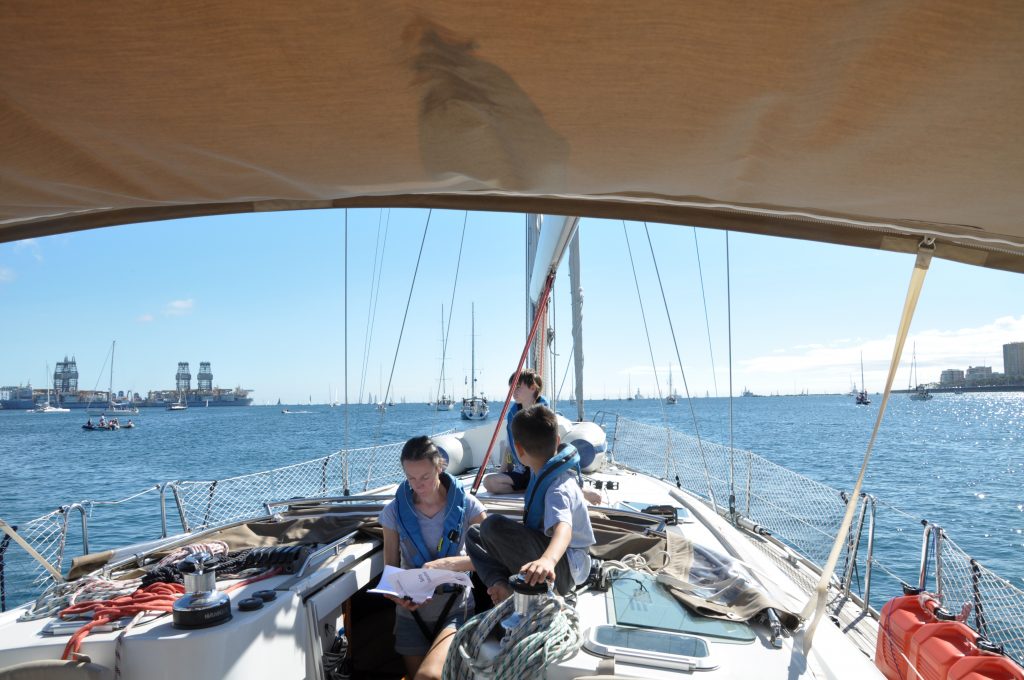
As we unfurled our sails we hit our first problem when the drum on our primary (and only electric) winch started lifting off the base. This was a little surprising as I’d spent a couple of days the week before trying (and failing) to work out how to remove the drum. 30 minutes before the start line for an ocean crossing was not the best time to find out. This was Day 1 and our first gear failure.
We crossed the line about 20 seconds after the gun and spent the next few hours dodging traffic. We were running dead down wind but with light winds a lot of boats were flying gennakers so would criss cross over our path.
By early evening the pack had thinned out, and though we could still see many boats around us the the close passes had died down. There was a half moon out so we had good visibility – always nice on the first night out, and we could still see 40 – 50 boats around us on AIS.
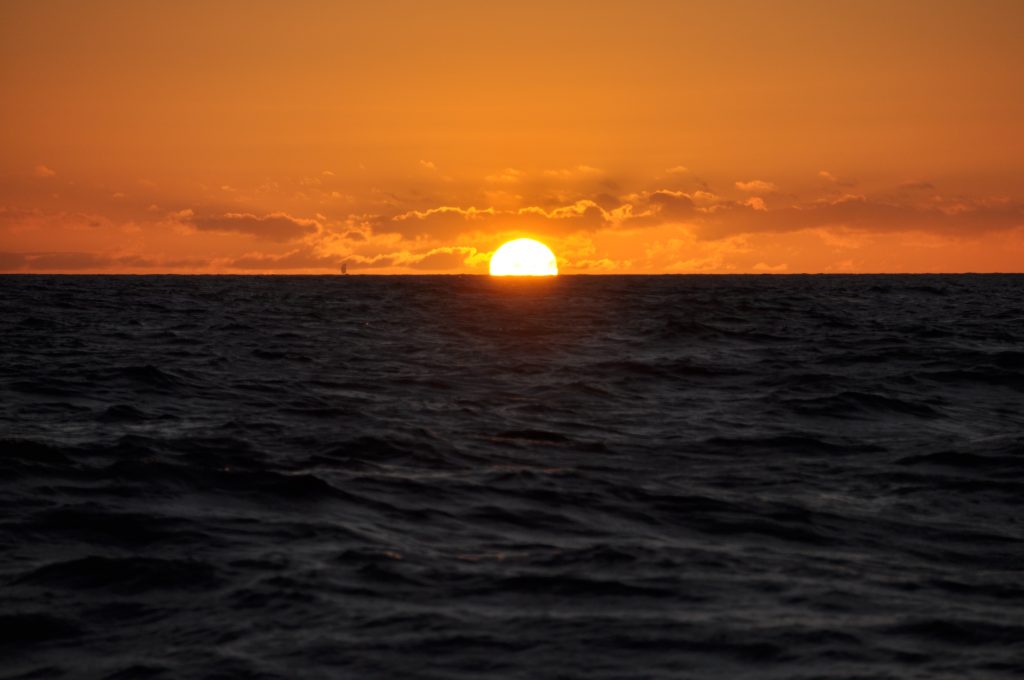
Day 2 was fairly unremarkable. Lots of other boats still in sight both visually and on AIS. Light winds but we wanted to settle into the sailing a bit before trying our gennaker. With 3 adults on board we went with a watch schedule of 3h on 6h off at night and repeated in the morning, then 2h on 4h off in the afternoon.
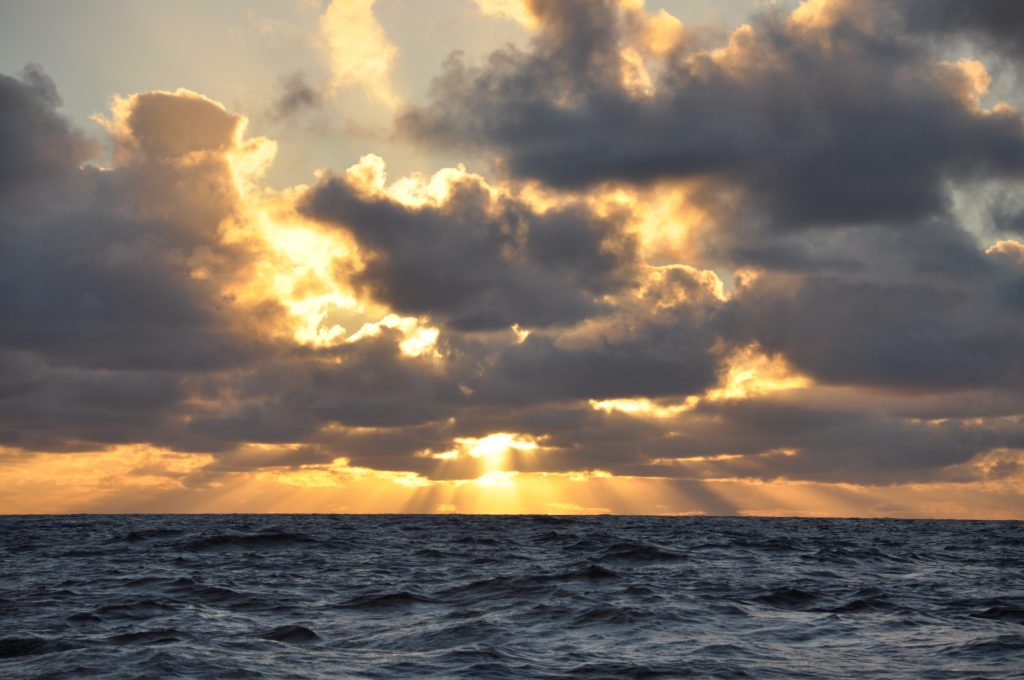
On Day 3 we continued to have light winds of 12 – 15 knots and we were dropping back in the pack so we decided to get the gennaker out. The gennaker is a lightweight downwind cruising sail, ideal for running at about 150 degrees off the wind. Ours has a snuffer sock so the sail is raised inside the sock, then the sock is hoisted clear to allow the sail to fill. To douse the sail the sock is pulled down over the sail, gradually snuffing the wind out. It works fairly well but does require a trip to the foredeck to launch and retrieve.
The gennaker went up easily and we immediately picked up over a knot of boat speed. The sun was shining and we were making about 7.5 knots, just about our ideal speed. After a couple of hours of pleasant sailing we suddenly heard another bang – this time the gennaker halyard which had parted, dropping the gennaker in the water. We were still running downwind at about 5 knots so retrieving it was a fair undertaking. The sail itself was relatively easy to haul in over the side but the snuffer had filled with water and was acting as a fairly effective drogue. Half an hour of hauling, manoeuvring and swearing later we had it back on board.
The halyard that parted was the only one capable of flying the gennaker, and the loose end had dropped inside the mast, so our main light wind option spent the rest of the crossing lashed to the side of the boat.
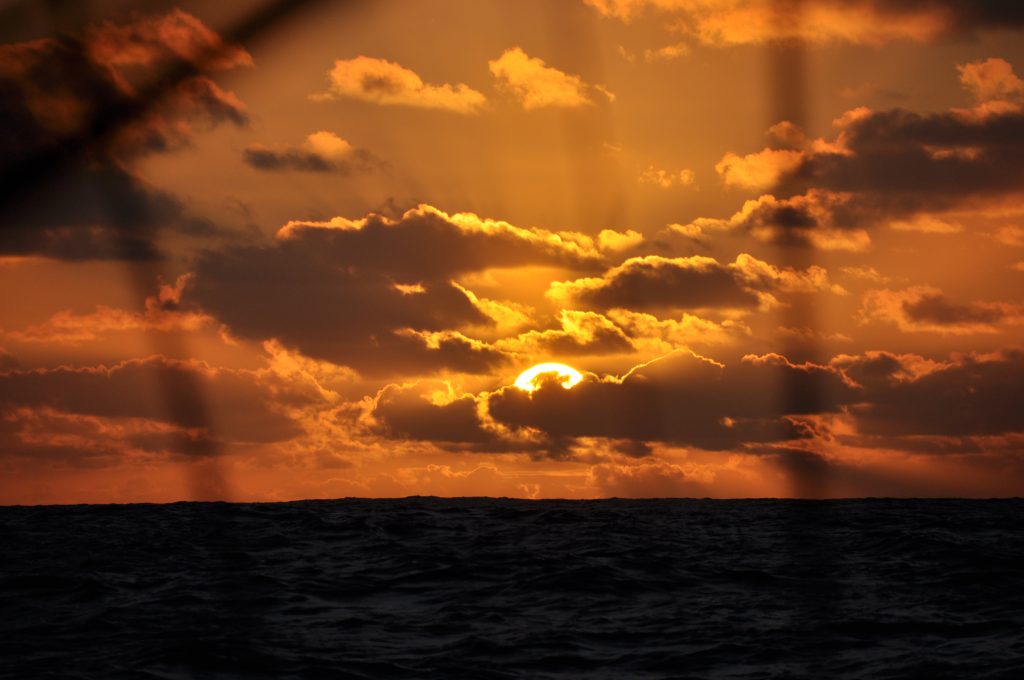
On Day 4 we switched to sailing wing on wing, with our headsail poled out on the opposite side to our main. This is a pretty decent configuration for us as we could reliably run about 165 – 170 degrees off the wind on autopilot, or completely downwind at 180 degrees hand steering. Despite the loss of the gennaker we were still sailing well and all seemed good, until a routine check of the bilge that night.
We had 3 through hulls fittings and valves replaced a few weeks previously in Almerimar, and when I checked the bilge there was water pooling around one of the new ones. It can be quite tricky working out the source of bilge water so despite the unappealing brown colour of the water we taste tested it, and sure enough it was salty. The prime suspect was one of the new through hulls and while the amount of water coming in was fairly minor, there was no way of knowing if 3 weeks of Atlantic swell could make it worse.
The typical ARC route is to head SW from the Canaries towards Cape Verde to get into the trade winds, before making more Westerly – so diverting to Cape Verde was an option and several boats had already done the same. We had a couple of days to decide so left it overnight. In the morning decided to take a systematic approach and close off all the underwater valves (13) on the boat – if the water continued to seep into the bilge that would point towards the suspected through hull, and if the water stopped that would suggest it was one of the valves. Fortunately it was the latter, and a bit more opening and closing of the valves led us to the generator. The seal in the water pump had failed and every time we ran the generator it leaked water into the bilge. Not a massive issue – we could stop the leak simply by closing that valve and not running the generator, or continue to use it and just mop up the bilge each time. In the middle of this I even managed to catch a nice little mahi-mahi.

After that little bit of drama we were quite relieved and started turning west to head more directly for St Lucia. A pod of minke whales came by a little later and we saw several of them breach just a few hundred feet ahead of us. This was our first sighting of whales and quite a treat.
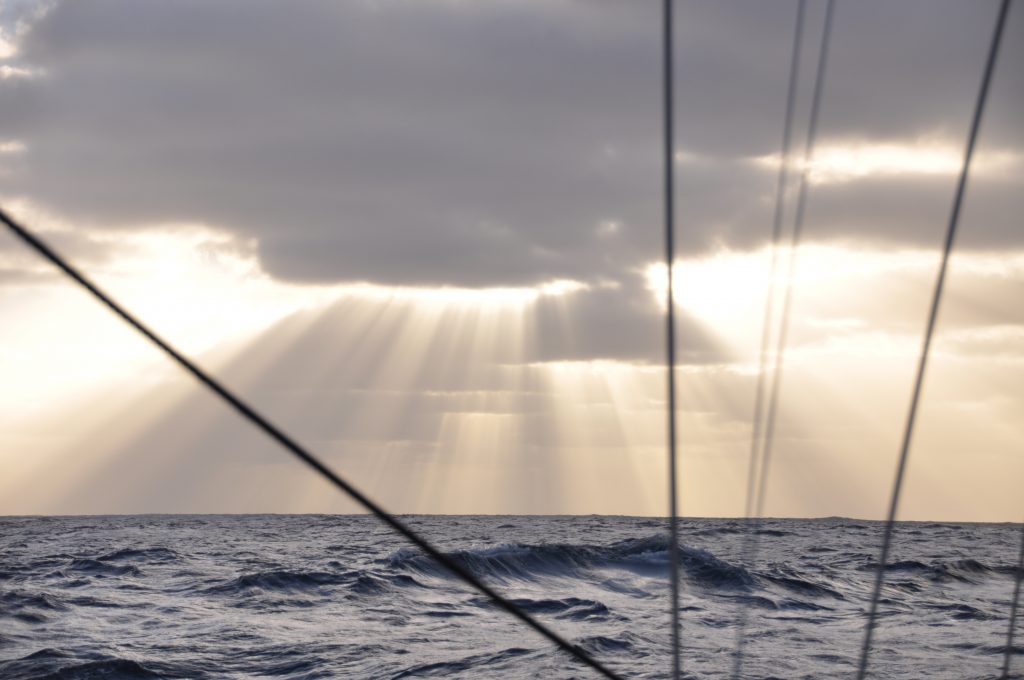
Day 5 wasn’t quite done with us yet though, when I found a small tear in the headsail during my night watch. Decided to leave it until morning to drop and repair.
Dropping sails whilst sailing downwind is not that straightforward, but with 20 knots of wind and 3 – 4m swells turning back into the wind wasn’t a fantastic option either. In the end we ran dead downwind so the headsail was mostly blanketed by the main, and I sat on the foredeck and hauled the genoa down on top of me. I then crawled out from under it and patched the tear with some heavy duty sail repair tape. We would repeat this 5 more times before we finished the crossing (Duct tape works much better than sail repair tape!).
As well as the consistent 3 – 4m swells coming from behind us, we also had a cross swell coming from the North which would hit us periodically and cause a bit of a lurch. In the early evening on Day 6 one of these caught Jennifer off guard while in the galley and flung her across the boat into the nav station seat. She managed to get one of the boys to get me and I found her lying on the cabin floor. Nothing seemed broken but at the very least she had badly bruised ribs. 18 hours of bed rest later and she was up and about again, but had to keep it light for several days and 3 weeks later is still a bit tender.
On Day 7 we had a day off from drama and a visit from a pod of dolphins. They hung around for almost an hour and played around the boat and the waves.

Day 8 started well, we sailed most of the day with the sails wing on wing with our headsail poled out. Then, late in the afternoon another bang and I came back up into the cockpit to see our whisker pole had snapped in half. When sailing wing on wing the whisker pole supports the headsail to keep it in position on the windward side of the boat. No pole means we either have to sail on a broad reach, so not directly in the path we are going but rather in a longer zig-zag, or continue dead down wind but with just our mainsail. The broad reach might have been OK if we still had our gennaker as the increase is speed would make up for the increased distance we would need to cover, but the gennaker was no longer an option. For me it was the most annoying of our problems so far as it would mean a much slower crossing for us.

Day 9. Out with the hack saw. A shorter pole is better than no pole. Our whisker pole is telescopic and it was the thinner inside tube that had snapped. I cut the bent (1m) section out of the inner tube and fitted the remaining sections back together. Our pole was now just over a metre shorter so we couldn’t put our full headsail out, but even with a shortened pole and headsail we managed to get pretty close to our ideal boat speed.
Day 10 was plesasantly uneventful. We had had fairly consistent weather since leaving Las Palmas, sunny most of the day and winds of 15 – 20 knots. Pretty ideal trade wind sailing. Squalls become more common the closer you get to the Caribbean but so far we hadn’t seen any. We kept a visual watch for them through the day then a radar watch at night.
On Day 11 I was reading in the cockpit when I heard the noise of a blowhole snorting. I turned round in time to catch a minke whale just a few feet to the side of us. It stayed with us for about half an hour, circling round the boat and playing under the bow like a dolphin.
The next few days passed fairly uneventfully. I found this time mid ocean the most enjoyable – we had dealt with all the breakages and were far enough out that landfall was a distant concern. The days rolled nicely into each other and it was quite literally plain sailing.
Around midnight on day 13 I heard a twang in the cockpit and turn round to see our danbuoy and lifebuoy were missing – looking behind I could see the flashing light that is attached to them blinking away. Turning the boat around into following seas takes a bit of effort, but the danbuoy is pretty key safety gear for a man overboard. We also knew there were boats following us and worried that another boat might see the flashing light and needlessly investigate. I woke Jennifer from her off watch and we furled the headsail, turned the engine on, and headed back.
It only took about 15 minutes to get back to the danbuoy, and I was pleasantly surprised at how visible it remained at 1/2nm away in 3m seas. Unfortunately I ran over the line tying the danbuoy to the lifebuoy, so it took us (Dawn had also woken up and joined us) about 30 mins to retrieve both into the boat. One to work on if we ever have to recover a real MOB.

On day 16 we saw another minke whale – this one was breached several times off our port bow. One more time and I would have managed to get the zoom in enough, but had to settle with a distant shot.
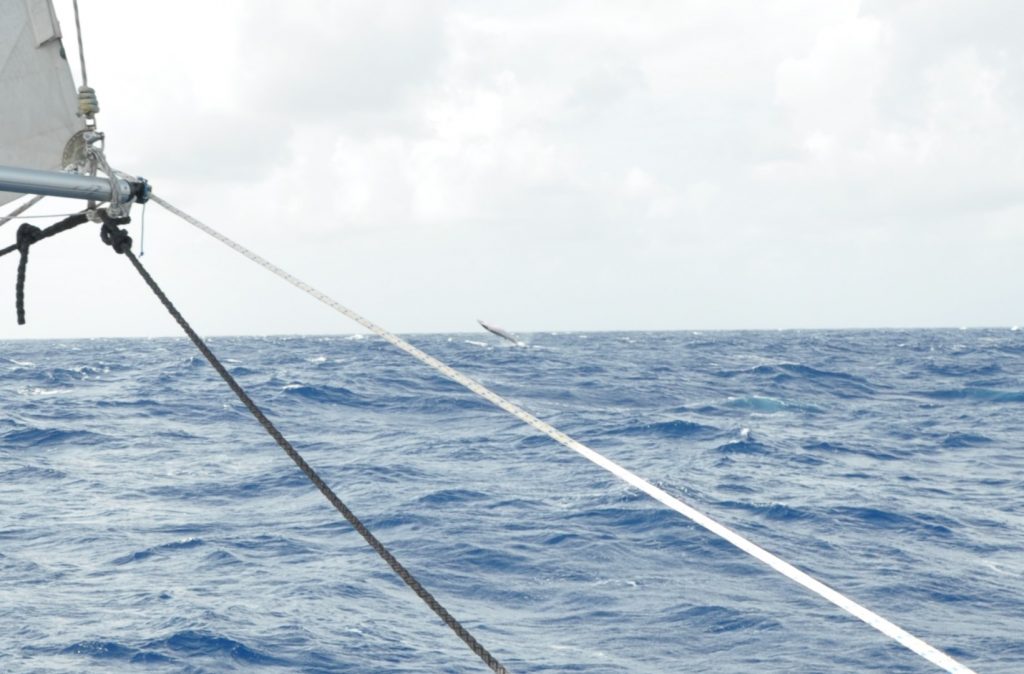
By now we were nearing the end of the crossing, and were all looking forward to getting in. The winds frustrated is a little on the last couple of days, but despite this we still made it in ahead of our schedule, and crossed the finish line after 18 days, 13 hours and 22 minutes.
We finished 10th out of 15 in our class. Given the loss of our gennaker and that we couldn’t use our full headsail going downwind, I was pretty happy with this.
We had one final drama to deal with. We had crossed the line around 10:30pm and as we were heading into the marina we fouled our propeller. It was a squally night so getting a tow in wasn’t a great option, and diving the boat at night was also pretty unappealing. Instead we dropped anchor where we were, had a quick drink then turned in.
Bright and early the next morning I dove the boat and removed the line from the propeller. We then proceeded into Rodney Bay marina to a welcome from the ARC staff, and rum punch from the St Lucia tourist board.
2 responses to “Day 145 to 162 – Las Palmas to St Lucia – The ARC”
Thrilling to read and glad you are all OK.
This is so enjoyable reading your of your exploits . You appear to be able to deal with any emergency although I’m sure that at the time it must have been a bit hairy. Please let know how the boys are enjoying their adventure. Have a lovely Christmas in St Lucia.
Muriel & Frank